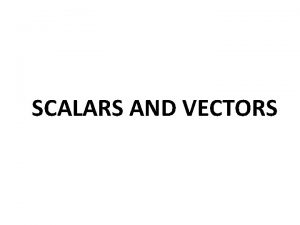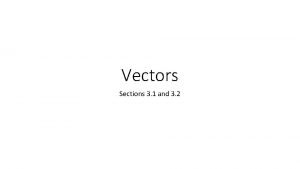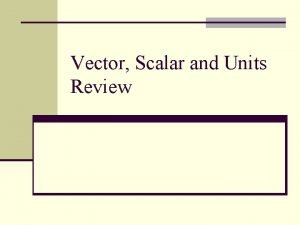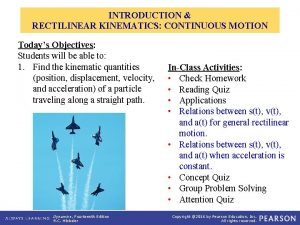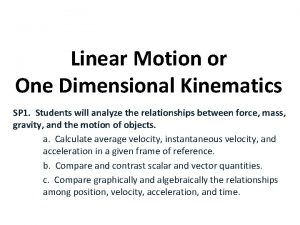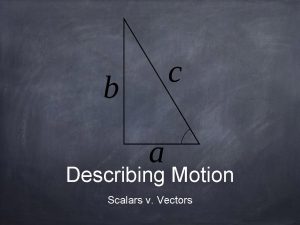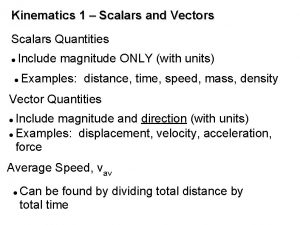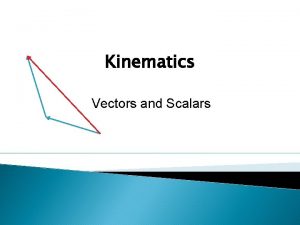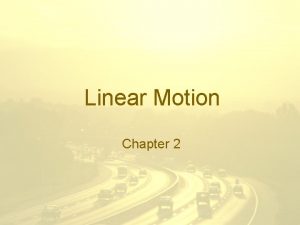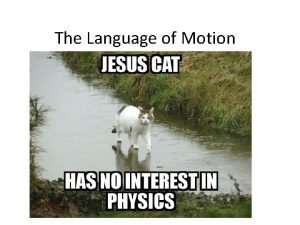Introduction to Kinematics Vectors Scalars and Motion Vector











- Slides: 11

Introduction to Kinematics Vectors, Scalars, and Motion!

Vector vs. Scalar Quantities • Scalar Quantities: – Only has magnitude • Vector Quantities: – Have magnitude AND direction – Represented with an arrow – + or – indicates the direction

Distance vs. Displacement • Distance • How far you have travelled • Displacement • How far you are from your starting point • + or – indicates direction

Speed vs. Velocity • Speed • How fast an object is moving • More precisely, it’s the rate at which an object covers distance • Velocity • The rate at which an object changes its position (displacement!) • + or – indicates direction

More About Velocity • Average Velocity: the overall displacement covered in a given time period • Units = m/s = m·s-1 *Note: average speed = total distance per unit time • Instantaneous Velocity: The speed and direction of a moving object at a particular instant in time – Initial velocity v i – Final velocity v f

Acceleration • Acceleration: ANY change in velocity – Speeding up (final velocity is a larger magnitude than the initial velocity) – Slowing down (final velocity is a smaller magnitude than the initial velocity) – Changing directions (the direction of the vector is changing) • Average Acceleration: the rate at which velocity is changing • Units = m/s 2 = m·s-2

• Speeding up Positive velocity, positive acceleration OR Negative velocity, negative acceleration Speeding up occurs when velocity and acceleration are in the same direction • Slowing down Positive velocity, negative acceleration OR Negative velocity, positive acceleration Slowing down occurs when velocity and acceleration are in the opposite direction.

Setting coordinate system • Determine which direction is the positive direction and which is the negative direction. – Traditionally, the positive direction is up or right, but as long as you’re consistent within the problem, it is up to you. • Determine which quantities in the problem are vectors and draw vector arrows in your diagram representing their relative size and direction

Problem solving strategy – Sketch the problem • Establish a coordinate system, determine “ 0” position • Diagram the scenario in the problem, labeling all important known and unknown quantities – What do you know? • List all known variables including units – What do you want to know? • List any unknown variables—these are what you need to solve for – List the appropriate equation – Plug and chug • Insert all known quantities, including units; calculate your answer. – Double check your work

REMEMBER: Scalar or Vector? • Scalar quantities have size only and no direction. • Vector quantities have both size and direction. Scalar 1. Mass 2. Distance 3. Displacement 4. Speed 5. Velocity 6. Energy 7. Time 8. Power 9. Momentum 10. Acceleration 11. Force Vector

Practice Problems (do these in your journal!) 1. Josie jogs around a 400 m track around the football field. It takes her 80 s to complete a lap a) What is Josie’s distance after 1 lap? Displacement? b) What is her speed after 1 lap? Average velocity? 2. A dog runs +5 m to get a ball. He then turns around at runs 2 m back to his owner. What distance did he run? What is his displacement? 3. A car travels +20. 0 m in 2. 0 s. It then backs up 4. 0 m in 1. 0 s. What is the average velocity of the car? Speed? 4. A car accelerates from +8. 0 m/s to +20. 0 m/s in 3. 0 s. Find it’s acceleration. 5. Find the acceleration of a motorcycle that slows down from 18 m/s to 0. 0 m/s in 6. 0 s.
 A storm system moves 5000 km due east
A storm system moves 5000 km due east Scalars and vectors
Scalars and vectors Scalar vs vector difference
Scalar vs vector difference Scalars and vectors
Scalars and vectors Vectors form 3
Vectors form 3 Multiplying or dividing vectors by scalars results in
Multiplying or dividing vectors by scalars results in Vector vs scalar
Vector vs scalar Aplusphysics kinematics-horizontal kinematics
Aplusphysics kinematics-horizontal kinematics Extension of scalars
Extension of scalars Rectilinear kinematics
Rectilinear kinematics What is continuous motion in dynamics
What is continuous motion in dynamics Constant speed tape chart
Constant speed tape chart



